

MOOCs: What role do they have in higher education? After working in the field of Instructional Technology for almost twenty years, I’ve seen many technologies that might impact higher education come and go.

In the initial stages, universities often experiment with the latest gadgets or Internet services without thinking too much about the concrete, real-world applications the technologies might have. MOOCs – Massive Online Open Courses – are a new model for online courses that have quickly gained interest and support among universities in recent months. We still find ourselves at the experimental stage, but it’s not too early to think about what kind of long-term impact MOOCs might have in higher education. Explore a New Learning Frontier: MOOCs by Inge de Waard: Page 2. Social media are at the center of any MOOC A MOOC is delivered online.
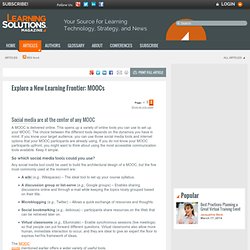
This opens up a variety of online tools you can use to set up your MOOC. The choice between the different tools depends on the dynamics you have in mind. If you know your target audience, you can use those social media tools and internet options that your MOOC participants are already using. If you do not know your MOOC participants upfront, you might want to think about using the most accessible communication tools available. So which social media tools could you use? Any social media tool could be used to build the architectural design of a MOOC, but the five most commonly used at the moment are: A wiki (e.g., Wikispaces) – The ideal tool to set up your course syllabus.A discussion group or list-serve (e.g., Google groups) – Enables sharing discussions online and through e-mail while keeping the topics nicely grouped based on their title.
The MOOC Guide. The purpose of this document is two-fold: - to offer an online history of the development of the Massive Open Online Course (MOOC) - to use that history to describe major elements of a MOOC Each chapter of this guide looks at one of the first MOOCs and some early influences.

It contains these parts: - a description of the MOOC, what it did, and what was learned - a description of the element of MOOC theory learned in the offering of the course - practical tools that can be used to develop that aspect of a MOOC - practical tips on how to be successful Contribute to this Book You are invited to contribute. MOOC: Massive Open Online Course. Massive open online course.
Poster, entitled "MOOC, every letter is negotiable", exploring the meaning of the words "Massive Open Online Course" A massive open online course (MOOC /muːk/) is an online course aimed at unlimited participation and open access via the web.[1] In addition to traditional course materials such as filmed lectures, readings, and problem sets, many MOOCs provide interactive user forums to support community interactions among students, professors, and teaching assistants (TAs).
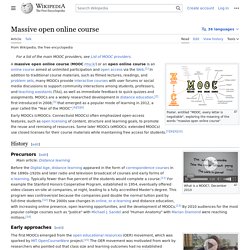
MOOCs are a recent and widely researched development in distance education which were first introduced in 2006 and emerged as a popular mode of learning in 2012.[2][3] Early MOOCs often emphasized open-access features, such as open licensing of content, structure and learning goals, to promote the reuse and remixing of resources. Some later MOOCs use closed licenses for their course materials while maintaining free access for students.[4][5][6][7] History[edit] Le MOOC, mode d'emploi. Le format MOOC (Massive Open Online Course) tend à prendre de l'importance dans l'offre de cours en ligne.
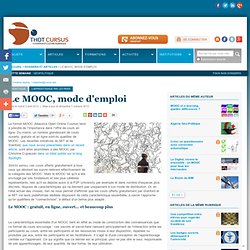
Du moins, un nombre grandissant de cours ouverts, gratuits et en ligne sont-ils qualifiés de MOOC. Les récentes initiatives du MIT et de Stanford, que nous avons présentées dans un récent article, sont ainsi assimilées à des MOOC par Christine Cupaiuolo dans un billet publié sur le blog Spotlight. Stricto sensu, ces cours offerts gratuitement à tous ceux qui désirent les suivre relèvent effectivement de la catégorie des MOOC. Mais le MOOC tel qu'il a été envisagé par ses fondateurs et ses plus célèbres représentants, tels qu'il se déploie aussi à la P2P University par exemple et dans nombre d'espaces plus discrets, dispose de caractéristiques qui ne tiennent pas uniquement à son mode de distribution. What is a MOOC? Knowledge in a MOOC. Success in a MOOC. Autour des MOOC.
Une page autour des MOOC, cours de masse en ligne et ouverts (Massive Open Online Course) Une collecte de références initiée par Michel Briand, avec la participation de Clément Dupiech, IMT Atlantique à compléter c'est un wiki ouvert !

Nous nous dirigeons vers un nouveau modèle radicalement ouvert, asynchrone et collaboratif. Les Cours En Ligne Ouverts et Massifs. La révolution du Mooc a commencée. Du moins en Amérique ….
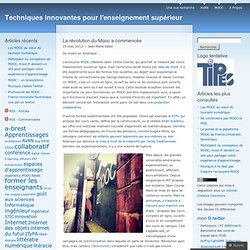
L’acronyme MOOC (Massive Open Online Course, qui pourrait se traduire par Cours massivement ouvert en ligne, mais l’acronyme serait moins joli) date de 2008. Il a été expérimenté sous des formes très ouvertes, au départ pour populariser la théorie du connectivisme par George Siemens, Stephen Downes et Davec Cormier. Un MOOC, c’est un cours en ligne, ouvert au sens où les contenus sont ouverts, mais aussi au sens où il est ouvert à tous.
Cette seconde acception d’ouvert est importante car pour fonctionner, un MOOC doit être massivement suivi, à savoir qu’il fonctionne d’autant mieux que le nombre d’inscrits est important. En effet, un élément central est l’interaction entre pairs. D’autres formes expérimentales ont été proposées. Mais depuis, les grandes universités américaines expérimentent, se positionnent, affichent leurs ambitions. Bref, cela bouge. L’idée de proposer des badges comme mode de certification. Like this: J'aime chargement… MoocGuide - 9. References. Fini A. (2009).
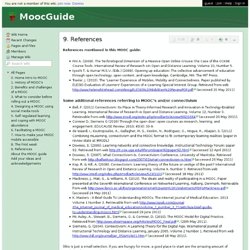
The Technological Dimension of a Massive Open Online Crouse: the Case of the CCK08 Course Tools. International Review of Research oin Open and Distance Learning. Volume 10, Number 5. Iiyoshi T. & Kumar M.S.V. What is the theory that underpins <em>our</em> moocs? If you’re even casually aware of what is happening in higher education, you’ve likely heard of massive open online courses (MOOCs).
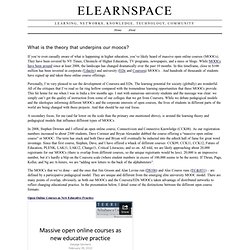
They have been covered by NY Times, Chronicle of Higher Education, TV programs, newspapers, and a mess or blogs. While MOOCs have been around since at least 2008, the landscape has changed dramatically over the past 10 months. In this timeframe, close to $100 million has been invested in corporate (Udacity) and university (EDx and Coursera) MOOCs . And hundreds of thousands of students have signed up and taken these online course offerings. Personally, I’m very pleased to see the development of Coursera and EDx.
A secondary focus, for me (and far lower on the scale than the primary one mentioned above), is around the learning theory and pedagogical models that influence different types of MOOCs. In 2008, Stephen Downes and I offered an open online course, Connectivism and Connective Knowledge (CCK08). What is the theory that underpins our MOOCs? 1. 2. 3. 4. MOOC.me - Welcome.